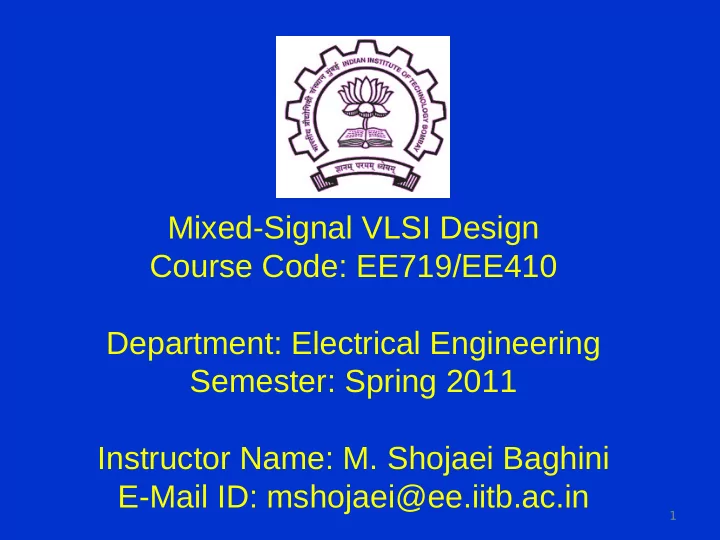

Mixed-Signal VLSI Design Course Code: EE719/EE410 Department: Electrical Engineering Semester: Spring 2011 Instructor Name: M. Shojaei Baghini E-Mail ID: mshojaei@ee.iitb.ac.in 1
2 2 Date: Jan. 14, 2011 Date: Jan. 14, 2011 Analog Filter Approximation Analog Filter Approximation (continuation from Lecture 02) (continuation from Lecture 02) Contents Contents Function Approximations Frequency Transformations Passive Filter to Active Filter Conversion IIT-Bombay Lecture 3 M. Shojaei Baghini
3 3 Brief Review of Analog Brief Review of Analog Filter Approximation Filter Approximation Butterworth Approximation (lecture 02) Chebyshev Approximation Elliptic Approximation Bessel Approximation IIT-Bombay Lecture 3 M. Shojaei Baghini
4 4 Reference Tables Reference Tables Element Values - Example Element Values - Example Normalized Butterworth LP Filter with Rs=RL=1 Butterworth LP Filter with Rs=RL=1 Normalized -3dB cutoff frequency of normalized normalized LP Butterworth filter = LP Butterworth filter = -3dB cutoff frequency of 1rad/s. 1rad/s. 5 4 IIT-Bombay Lecture 3 M. Shojaei Baghini
5 5 Chebyshev Approximation All-pole transfer function based on Chebyshev polynomials where poles lie on Chebyshev polynomials where poles lie on an ellipse. an ellipse. Chebyshev polynomials have local Chebyshev polynomials have local maximum and minimum values at finite maximum and minimum values at finite frequencies. frequencies. For normalized Chebyshev polynomials all For normalized Chebyshev polynomials all maximum and minimum values occur at maximum and minimum values occur at ⇒ r frequencies between -1 and 1 ⇒ ripple in ipple in frequencies between -1 and 1 passband. passband. IIT-Bombay Lecture 3 M. Shojaei Baghini
6 6 Chebyshev Approximation Source: Harry Y-F. Lam, 1979 IIT-Bombay Lecture 2 M. Shojaei Baghini IIT-Bombay Lecture 3 M. Shojaei Baghini
7 7 Elliptic Approximation Elliptic Approximation Finite Transmission Zeros Transmission Zeroes are poles of the elliptic rational functions (more details in filter design text books, e.g. Harry Y-F. Lam, 1979, ...) . Ripple in both pass band and stop band Steeper roll-off in transition band compared to BW and Chebyshev filter. IIT-Bombay Lecture 2 M. Shojaei Baghini IIT-Bombay Lecture 3 M. Shojaei Baghini
8 8 Comparison of Magnitude of Comparison of Magnitude of Normalized TF Normalized TF Butterworth Chebyshev type I Chebyshev type II Elliptic Source: Wikipedia IIT-Bombay Lecture 2 M. Shojaei Baghini IIT-Bombay Lecture 3 M. Shojaei Baghini
9 9 BW Filter Characteristics BW Filter Characteristics • Maximally flat in passband • No zero • No ripple in passband and stopband IIT-Bombay Lecture 2 M. Shojaei Baghini IIT-Bombay Lecture 3 M. Shojaei Baghini
10 10 Chebyshev Filter Characteristics Chebyshev Filter Characteristics Ripple in the passband No zero Narrower transition band compared to Butterworth Poorer group delay compared to Butterworth IIT-Bombay Lecture 2 M. Shojaei Baghini IIT-Bombay Lecture 3 M. Shojaei Baghini
11 11 Chebyshev Type II Filter Chebyshev Type II Filter Characteristics Characteristics No ripple in the passband Zeros in stopband Narrower transition band compared to Butterworth Improved group delay compared to Chebyshev IIT-Bombay Lecture 2 M. Shojaei Baghini IIT-Bombay Lecture 3 M. Shojaei Baghini
12 12 Elliptic Filter Characteristics Elliptic Filter Characteristics Ripple in the passband Zeros in stopband Narrower transition band and poorest group delay compared to Butterworth and two forms of Chebyshev filters IIT-Bombay Lecture 2 M. Shojaei Baghini IIT-Bombay Lecture 3 M. Shojaei Baghini
13 13 Bessel Approximation Bessel Approximation Phase Approximation Linear Phase (or Constant Group Delay) Approximation, having maximally flat delay response. The Bessel approximation has a smooth pass band and stop band response, like Butterworth but with less attenuation in stop band. All transmission zeros occur at s=infinite. IIT-Bombay Lecture 2 M. Shojaei Baghini IIT-Bombay Lecture 3 M. Shojaei Baghini
14 14 Magnitude Characteristics of Bessel Filters |H(j ) 2 | 1.0 0.8 0.6 0.4 0.2 0.0 Source: Harry Y-F. Lam, 1979 IIT-Bombay Lecture 2 M. Shojaei Baghini IIT-Bombay Lecture 3 M. Shojaei Baghini
15 15 Phase Characteristics of Bessel Filters Source: Harry Y-F. Lam, 1979 IIT-Bombay Lecture 2 M. Shojaei Baghini IIT-Bombay Lecture 3 M. Shojaei Baghini
16 16 Group Delay Characteristics of Bessel Filters 1.0 0.8 0.6 0.4 0.2 Source: Harry Y-F. Lam, 1979 IIT-Bombay Lecture 2 M. Shojaei Baghini IIT-Bombay Lecture 3 M. Shojaei Baghini
17 17 Properties – Bessel Filter Properties – Bessel Filter Similar to Butterworth but with wider transition band No zeros Low Q poles, outside unit circle makes group delay of Bessel filter the best compared to Butterworth, Chebyshev I & II and Elliptic filters. IIT-Bombay Lecture 2 M. Shojaei Baghini IIT-Bombay Lecture 3 M. Shojaei Baghini
18 18 Element Values - Example Element Values - Example Normalized Bessel LP Filter Bessel LP Filter Normalized with Rs=RL=1 with Rs=RL=1 Source: Harry Y-F. Lam, 1979 IIT-Bombay Lecture 2 M. Shojaei Baghini IIT-Bombay Lecture 3 M. Shojaei Baghini
19 19 Frequency Scaling Frequency Scaling IIT-Bombay Lecture 2 M. Shojaei Baghini IIT-Bombay Lecture 3 M. Shojaei Baghini
20 20 Frequency Scaling - Example Frequency Scaling - Example Scaling 1rad/s to 10 5 rad/s results in the following new values of components. 0.51H → 5.1 H 0.11H → 1.1 H 1.06F → 10.6 F 0.32F → 3.2 F IIT-Bombay Lecture 2 M. Shojaei Baghini IIT-Bombay Lecture 3 M. Shojaei Baghini
21 21 Frequency Transformation - Frequency Transformation - Example Example 1 -3dB BW=1 ω (rad/s) 0 1 ω (rad/s) -100k 0 100k -3dB BW=40Krad/s IIT-Bombay Lecture 3 M. Shojaei Baghini IIT-Bombay Lecture 2 M. Shojaei Baghini
Recommend
More recommend